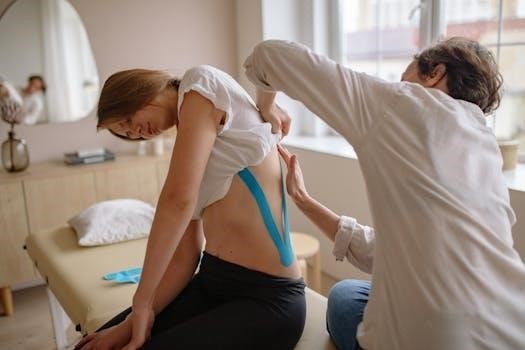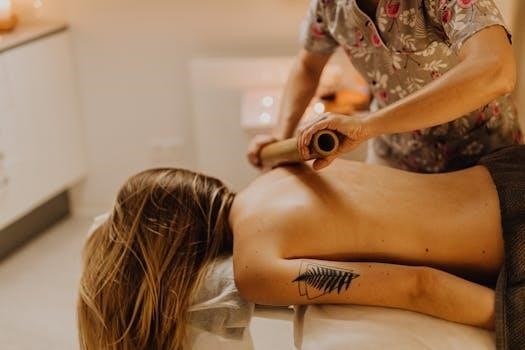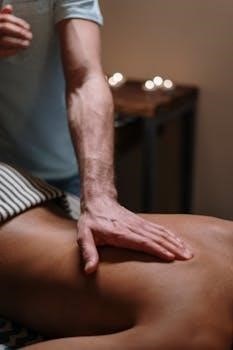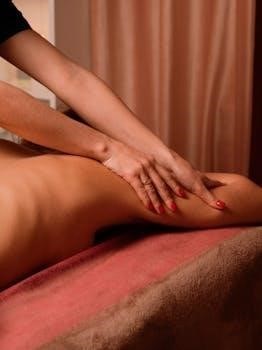This guide introduces the world of back massage, exploring various techniques for relaxation and therapeutic benefits. From basic strokes to advanced methods, discover how massage can ease tension, pain, and stress.
Understanding the Benefits of Back Massage
Back massage offers a multitude of advantages, extending beyond simple relaxation. It effectively alleviates muscle tension and stiffness, promoting greater flexibility and range of motion. Massage can significantly reduce back pain, a common ailment affecting many, by targeting tight muscles and trigger points. Furthermore, it enhances circulation, delivering essential nutrients and oxygen to tissues, which aids in healing and recovery. The therapeutic touch of massage helps to reduce stress and anxiety, promoting mental well-being. Through gentle manipulation and pressure, massage can also release endorphins, the body’s natural painkillers, providing relief and comfort. This practice is a powerful tool for self-care and overall health enhancement, and this guide offers practical steps to achieve these benefits. Regular massage contributes to a healthier, more balanced lifestyle, both physically and mentally, offering a non-invasive approach to pain and stress management.

Basic Swedish Massage Techniques
Explore fundamental Swedish massage techniques, including effleurage, petrissage, and tapotement. These methods form the basis for relaxation and therapeutic massage, offering a gentle yet effective approach.
Effleurage⁚ Long, Gliding Strokes
Effleurage is characterized by long, smooth, gliding strokes that are applied with varying pressure, often starting lightly and gradually increasing. These strokes are typically performed using the palms of the hands, and they follow the contours of the body. The direction of movement is generally towards the heart, promoting blood flow and lymphatic drainage. Effleurage serves multiple purposes during a massage. It is used to begin and end the massage, helping to warm up the muscles and relax the client. It also allows the therapist to assess the client’s muscle tone and identify areas of tension. Furthermore, effleurage helps to distribute massage oil evenly across the skin, making subsequent techniques more effective. This technique can also be soothing and helps to calm the client. The rhythm and pressure can be adjusted to suit the individual’s needs and comfort level. Effleurage is a fundamental component of Swedish massage and lays the groundwork for deeper tissue work.
Petrissage⁚ Kneading and Rolling
Petrissage involves a variety of techniques that include kneading, squeezing, and rolling the muscles. These actions are performed with the hands, fingers, and thumbs, and they aim to manipulate the soft tissues; The pressure used can vary from light to deep, depending on the client’s tolerance and needs; The benefits of petrissage are numerous. It helps to loosen tight muscles, improve blood circulation, and break down adhesions in the tissues. Kneading, in particular, is effective for releasing knots and tension points. Rolling techniques are useful for stretching and lengthening the muscles. Petrissage also aids in detoxification by promoting the removal of metabolic waste products. This technique is often incorporated after effleurage to work more deeply into the muscle layers. It can be applied in circular or linear motions and can be adjusted to target specific areas of concern. Petrissage is an essential component of Swedish massage and a key tool for addressing muscular imbalances.
Tapotement⁚ Percussive Techniques
Tapotement, also known as percussion, consists of rhythmic tapping, hacking, cupping, and pounding movements. These techniques stimulate the muscles and nervous system. The purpose of tapotement is to increase blood flow, invigorate the body, and release muscular tension. Tapping involves using the fingertips to gently tap the back, while hacking uses the sides of the hands in a chopping motion. Cupping uses cupped hands to create a hollow sound and a gentle suction; Pounding employs the fists to deliver a deeper, more forceful impact. These techniques are typically applied for short periods, as they can be quite stimulating. The intensity of the percussion is adjusted based on the client’s preference and condition. Tapotement is effective for loosening congestion in the respiratory system and is commonly used in sports massage to prepare muscles for activity. It is often performed after other massage techniques to provide a final energizing effect. Practitioners should be mindful of applying these techniques safely, ensuring proper form to avoid discomfort.

Advanced Back Massage Techniques
This section delves into specialized massage approaches, such as deep tissue and trigger point therapy, designed to target specific issues like chronic muscle tension and pain relief.
Deep Tissue Massage for Muscle Tension
Deep tissue massage is a technique focused on reaching the deeper layers of muscle and fascia to alleviate chronic tension. This method involves applying firm pressure and slow strokes to target knots and adhesions within the muscle tissue. Unlike a gentler massage, deep tissue work aims to release the tension that resides deep within. The practitioner might use their fingers, thumbs, or elbows to reach these areas, often following the direction of blood flow. This technique is highly effective for those with persistent muscle pain, stiffness, or restricted movement. It’s important to communicate with your massage provider about pressure tolerance, as deep tissue can be intense but is ultimately designed to promote lasting relief and improve muscle function. This is not simply about pressing hard; it’s about working with the body to gradually release deep-seated tension.
Trigger Point Therapy for Pain Relief
Trigger point therapy is a specialized massage technique that focuses on identifying and releasing specific areas of muscle tightness known as trigger points. These points are often associated with localized pain or referred pain, meaning pain that radiates to other parts of the body. The therapy involves applying direct pressure to these trigger points for a sustained period, which can initially cause discomfort before resulting in relief. By releasing trigger points, this massage can help alleviate pain, improve range of motion, and restore normal muscle function. The therapist may use their fingers, thumbs, or elbows to apply pressure, and often, the client is actively involved in communicating their sensations. This technique can be particularly beneficial for individuals with chronic pain conditions, postural imbalances, or those who experience muscle spasms, and can be an effective method for breaking the cycle of pain. It is crucial to work with a skilled practitioner for effective results.

Self-Massage Techniques for the Back
Explore methods for self-care, using tools like massage rollers and simple techniques. This section provides guidance on how to reach and massage your own back effectively for stress relief.
Using Massage Rollers for Self-Care
Massage rollers are fantastic tools for self-massage, offering a convenient way to target back muscles. These devices come in various shapes and sizes, each designed to address different areas of the back and levels of tension. Using a foam roller, for example, allows you to apply pressure to tight spots, helping to release knots and improve circulation. Start by slowly rolling up and down your back, focusing on areas that feel particularly stiff or sore. Pay close attention to the pressure you are applying and adjust it as needed. These simple tools can be a great addition to your self-care routine, especially if you often experience back discomfort. Remember to use them gently to avoid any injury. Regular use of massage rollers can improve your overall back health and well-being. They are a great option for those seeking to relieve tension in between professional massage sessions.
Simple Techniques for Reaching the Back
Reaching your back for self-massage can be challenging, but several simple techniques can help. One method involves using a tennis ball or a similar sized ball against a wall or floor. By leaning against the ball, you can control the pressure and slowly roll it over tight muscles. Another effective approach is using your hands to reach as far as possible and apply gentle kneading motions. A towel can also be helpful; holding the ends of a towel and using it to scrub your back can provide relief and improve circulation. Consider using a massage cane, a tool designed to reach tricky spots on your back with greater ease. Experiment with these simple methods to discover what works best for you, and remember that even small amounts of self-massage can bring significant relief. These techniques are useful for addressing muscle soreness and improving flexibility.
Massage Considerations and Safety
Prioritize safety during back massage by understanding contraindications and using proper body mechanics. This ensures both the receiver’s and the giver’s well-being, promoting a positive experience.
Contraindications for Back Massage
Before initiating any back massage, it’s crucial to be aware of certain contraindications, where massage might be harmful. Avoid massage in areas with acute inflammation, such as recent injuries or sprains, as it may exacerbate the condition. Individuals with fever or contagious skin conditions should postpone massage until fully recovered to prevent transmission. Those with blood clots, deep vein thrombosis, or severe circulatory issues should not receive massage, as it can dislodge clots or cause further complications. Similarly, people with active infections, cancer, or certain heart conditions may find massage to be detrimental. Individuals with fragile bones, such as osteoporosis, should avoid deep pressure. Always consult a healthcare professional if you have any concerns or pre-existing conditions. Remember that safety is paramount, and understanding these contraindications ensures a beneficial and safe massage experience.
Proper Body Mechanics for Massage Providers
Maintaining proper body mechanics is essential for massage providers to prevent injury and ensure effective treatment. A stable stance with feet shoulder-width apart and knees slightly bent provides a solid foundation. Keep your back straight, engaging your core muscles to support your spine throughout the massage. Avoid bending at the waist; instead, move from your hips and legs. When applying pressure, use your body weight rather than relying on arm strength to minimize strain. Maintain a neutral wrist position and avoid gripping too tightly. Adjust the massage table height to a comfortable level, allowing you to work without hunching or reaching. Vary your stance and technique to avoid repetitive strain. Regularly stretch and take breaks to prevent fatigue and maintain your physical well-being; By adhering to these principles, massage providers can enjoy a long, fulfilling career without compromising their health.

Illustrated Guides and Resources
This section offers visual aids, practical books, and step-by-step guides to enhance your learning. Explore detailed illustrations and resources that offer clear instructions for effective massage techniques.
Using Visual Aids for Learning Techniques
Visual aids play a crucial role in understanding and mastering back massage techniques. Step-by-step photographs and clear illustrations provide a practical way to learn the correct hand movements, body positioning, and pressure application for each massage stroke. These visual resources enable learners to see exactly how techniques should be performed, making it easier to replicate them effectively. By observing the flow of movements, users can better grasp the nuances of massage and ensure they are applying the right techniques for relaxation and therapeutic relief. Whether you are a beginner or an experienced practitioner, visual aids offer valuable support. Furthermore, incorporating visual resources into your learning process allows for a more intuitive understanding of the massage process. These illustrations help to clarify how different massage techniques work on the body’s muscles and tissues, enhancing the overall learning experience. Using visual aids in your training ensures proper technique, resulting in safer and more effective massages. From effleurage to tapotement, these resources can help you master various massage techniques.
Practical Books and Step-by-Step Guides
Practical books and step-by-step guides are essential resources for anyone seeking to master back massage techniques. These guides often combine detailed instructions with high-quality photographs, making it easy to understand and apply various massage methods. They provide a structured approach to learning, from basic strokes to advanced therapies. Many guides also cover the background and rationale behind different massage treatments, offering a comprehensive understanding of their benefits. These resources can help both beginners and experienced practitioners alike refine their skills and deepen their knowledge. Furthermore, some books include tips on soothing self-massage techniques to ease stress, providing helpful guidance for personal care. Step-by-step instructions ensure that each technique is performed correctly, promoting safety and effectiveness. You will find information on a wide range of massage treatments, from Western methods to Eastern practices. These guides often include illustrations to further clarify the techniques. With the aid of practical books and guides, you can confidently perform massages for relaxation and therapy.
